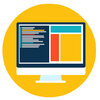Top 20 Django Interview Questions and Answers
Updated 13 Jul 2025

Asked in Globant

Q. Where would you use Flask, and where would you use Django?
Flask is lightweight and good for small projects, while Django is more robust and suitable for larger projects.
Flask is good for small projects with simple requirements
Django is more suitable for larger projects with complex requirements
Flask is ligh...read more
Asked in Moonhive

Q. What is the use of middleware in Django Settings.py?
Middleware in Django Settings.py is used to modify the request/response objects, process requests before they reach the view, and responses before they are sent to the client.
Middleware classes are defined in the MIDDLEWARE setting in settings.py
They...read more

Asked in Damco Solutions

Q. What are Django signals?
Django signals allow certain senders to notify a set of receivers that some action has taken place.
Signals allow decoupled applications to get notified when certain actions occur elsewhere in the application
They are used to avoid coupling between app...read more

Asked in Damco Solutions

Q. What is the Django request response cycle?
Django request response cycle is the process of handling a request and generating a response in Django web framework.
Client sends a request to the server.
The request is received by the Django server.
Django uses URL patterns to match the requested URL...read more

Asked in Calsoft

Q. How does the Django framework work?
Django is a high-level Python web framework that follows the model-view-controller architectural pattern.
Django uses the MTV (Model-Template-View) architectural pattern.
It provides a robust set of tools and libraries for building web applications.
Dja...read more


Q. What is Django middleware?
Django middleware is a component that sits between the web server and the view, allowing for processing of requests and responses.
Middleware is a way to modify or process requests and responses globally in a Django application.
It can be used for auth...read more



Q. How do you create APIs using Django?
To create APIs in Django, you can use Django REST framework to define serializers, views, and urls.
Use Django REST framework to create serializers for data models
Define views to handle API requests and responses
Map URLs to views using Django's URL pa...read more

Asked in UST

Q. Explain Django forms.
Django forms simplify form handling in web applications, providing validation, rendering, and data processing features.
Django forms are Python classes that define the structure and behavior of web forms.
They handle form validation, ensuring user inpu...read more
Asked in Foresiet

Q. How do you scale a Django application?
Scaling a Django application involves optimizing performance, increasing capacity, and improving efficiency.
Use caching to reduce database queries and improve response times
Implement load balancing to distribute traffic evenly across multiple servers...read more

Asked in Leader Group

Q. What is bench migrate?
Bench migrate is a command used in Django to apply database schema changes.
Bench migrate is used to update the database schema to match the current codebase.
It is a command used in Django to apply database schema changes.
It is used to create, modify ...read more
Django Jobs




Asked in Humanit Solutions

Q. How can Django be used to retrieve product details?
Django's ORM can be used to find product details by querying the database.
Define a model for products in models.py
Create a view function to handle the request
Use the ORM to query the database for the product details
Render the details in a template

Asked in DGLiger Consulting

Q. What is a Django model?
Django model is a Python class that represents a database table and its fields.
Django models define the structure of database tables
Each model class corresponds to a table in the database
Models can have fields like CharField, IntegerField, ForeignKey...read more

Asked in HOPE Foundation

Q. Why Django over Flask?
Django is preferred for larger, more complex web applications due to its built-in features and batteries-included approach.
Django provides a more comprehensive set of features out of the box compared to Flask.
Django includes an ORM, admin panel, auth...read more

Asked in Techsolvo

Q. What are some basic tasks in Django?
Basic tasks in Django include creating models, views, templates, URLs, and forms.
Creating models to define database structure
Creating views to handle user requests and return responses
Creating templates to generate HTML output
Defining URLs to map req...read more

Asked in i2Soft Technologies

Q. What are Django fixtures?
Django fixtures are files that contain pre-defined data to be loaded into a Django database.
Fixtures are used to populate the database with initial data.
They are written in JSON, XML, or YAML format.
Fixtures can be used for testing, seeding data, or ...read more
Asked in Growify Digital

Q. How would you develop an API using Django?
Developing APIs using Django involves creating views, serializers, and urls to interact with data.
Create Django project and app
Define models for data structure
Create serializers to convert data to JSON
Write views to handle API requests
Define urls to ...read more

Asked in Mindfire Solutions

Q. Explain Django's request-response flow.
Django's request response flow involves the request being handled by URL dispatcher, views, middleware, and templates before generating a response.
Request is received by URL dispatcher which maps the URL to a view function
View function processes the ...read more

Asked in Antino

Q. What are Django generic views?
Django generic views are pre-built views provided by Django to simplify common tasks like displaying data from a database.
Django generic views help reduce code duplication by providing ready-to-use views for common tasks like displaying objects from ...read more
Asked in StudentSpace

Q. What is the Django REST Framework?
Django REST Framework is a toolkit for building web APIs in Django, providing tools for serialization, authentication, and viewsets.
Provides tools for serialization, authentication, and viewsets
Makes it easier to develop RESTful services in Django
Inc...read more

Asked in HP India

Q. Django rest framework implementation
Django rest framework is a powerful and flexible toolkit for building Web APIs in Django.
Django rest framework allows you to easily build RESTful APIs in Django by providing serializers, views, and authentication.
It includes built-in support for pagi...read more

Asked in Globant

Q. What are the key differences between Flask and Django?
Flask is a micro web framework while Django is a full-stack web framework.
Flask is lightweight and flexible, allowing developers to choose their own libraries and tools.
Django is a batteries-included framework with built-in ORM, admin interface, and ...read more

Asked in Techjays

Q. What is middleware in Django?
Middleware in Django is a framework of hooks into Django's request/response processing.
Middleware is a framework of hooks that allows you to modify request/response objects globally.
It is a lightweight, low-level plugin system for globally altering D...read more

Asked in Horizontal Integration

Q. What is the difference between Flask and Django?
Flask is a micro web framework while Django is a full-stack web framework.
Flask is lightweight and flexible while Django is more structured and includes many built-in features.
Flask is better for small to medium-sized projects while Django is better ...read more

Asked in Techbrawn

Q. What is Django in Python?
Django is a high-level Python web framework that encourages rapid development and clean, pragmatic design.
Built-in admin interface for easy management of application data.
Follows the MVC (Model-View-Controller) architectural pattern.
Includes an ORM (...read more
Top Interview Questions for Related Skills
Interview Experiences of Popular Companies



Interview Questions of Django Related Designations



Reviews
Interviews
Salaries
Users











